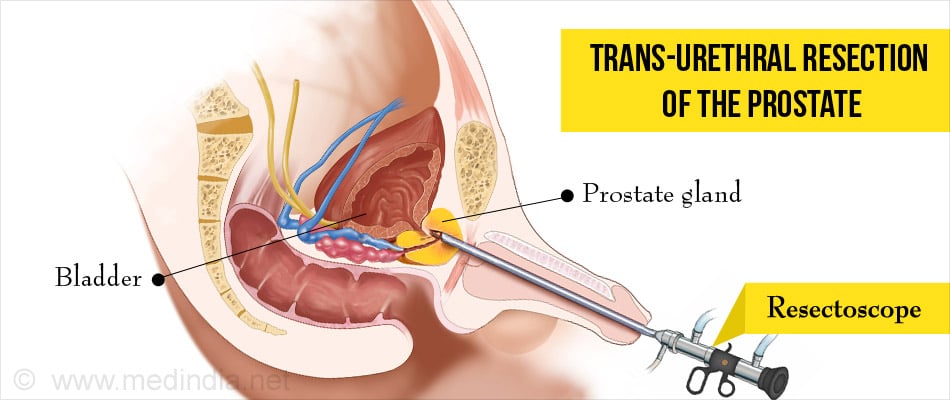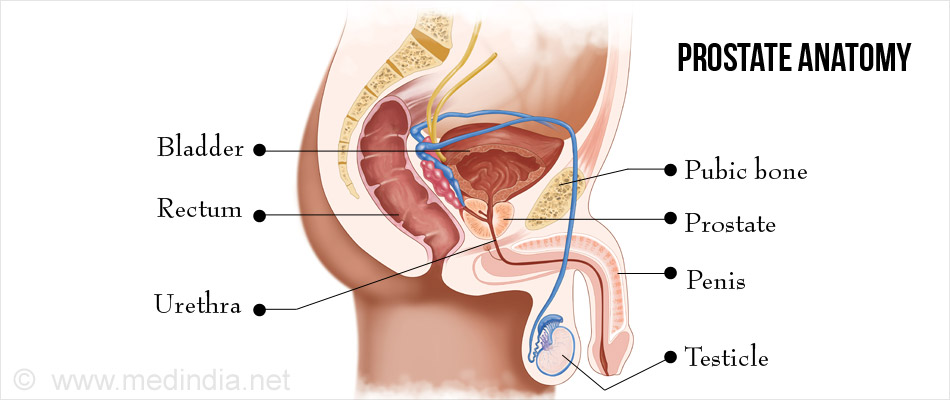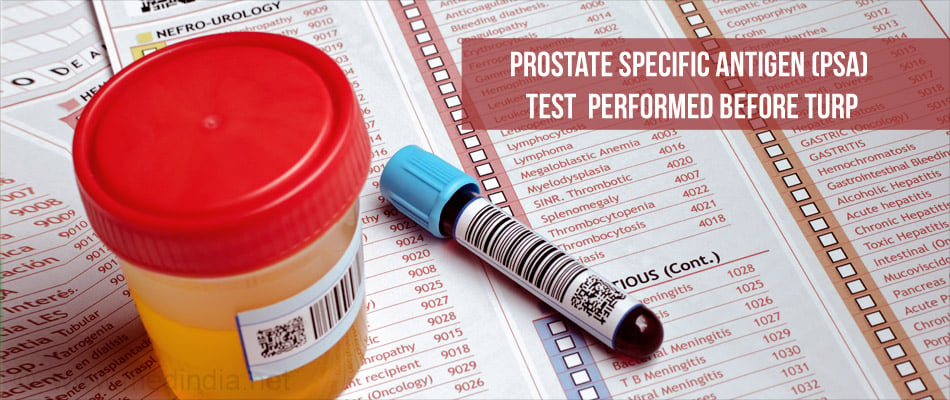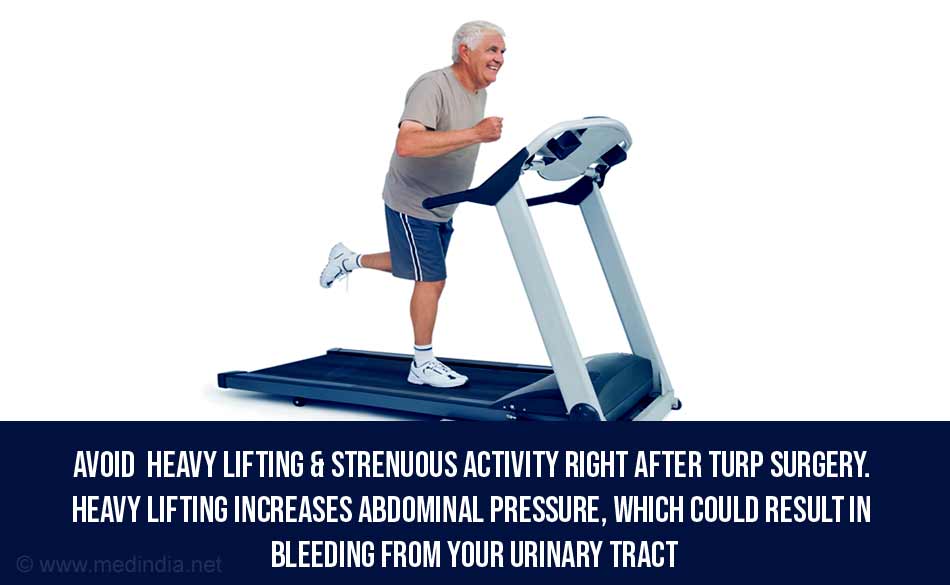What is a Trans-Urethral Resection of the Prostate Surgery?
Trans-urethral resection of the prostate (TURP) is an effective minimally-invasive surgical procedure used in the treatment of a non-cancerous enlargement of the prostate, referred to as benign prostatic hyperplasia (BPH). In this procedure, a part of the prostate that obstructs the urethra is removed with the help of an instrument that is passed through the urethra.
TURP is an endoscopic procedure and does not involve a surgical incision and is performed by urologist. Once the obstructed tissue of the prostate gland is removed it allows urine to flow more freely. The urologist passes a special thin tube through your urethra and uses a heated wire loop to shave off the overgrown areas of the prostate gland.

Not everybody with an enlarged prostate gland will require a TURP; however the urologist may recommend this procedure on the basis of symptoms and the results of special investigations they carry out. By allowing urine to flow more freely, a TURP can often relieve or reduce symptoms.
Anatomy of the Prostate
The prostate is a small walnut-sized gland that forms a part of the male reproductive system. It is located just below the urinary bladder, behind the pubic symphysis and in front of the rectum. It surrounds the upper part of the urethra, referred to as prostatic urethra.
The urethra is the duct which passes through the penis and carries the urine to the exterior. The posterior wall of the prostatic urethra has the urethral crest, with a prominent elevation called the verumontanum. The secretion from the prostate, the prostatic fluid empties into the prostatic sinuses, which open on either side of the urethral crest. The ejaculatory ducts, which carry sperms and fluid from the seminal vesicles, open into the verumontanum.
Just below the verumontanum is the external urethral sphincter, which helps to control urine flow. Damage to the sphincter can result in urinary incontinence. Therefore, the surgery on the prostate should not go beyond the verumontanum to prevent damage to the external urethral sphincter.

Which Patients Require TURP?
TURP is used for the treatment of benign hyperplasia of the prostate (BPH). BPH is a condition that often affects older men. The prostate is enlarged in size and can affect the flow of urine through the prostatic urethra. TURP is used in those patients with symptoms of urinary retention in whom medical treatment does not work or those who suffer from complications like bladder stones, repeated urinary tract infections or even kidney failure. It may also be used to treat urinary obstruction caused by prostate cancer.
What are the Tests Done Before the TURP Surgery?
Before a TURP, the doctor examines the patient. A digital rectal examination is carried out to assess the size and surface of the prostate. During the examination, the patient lies on his side with legs folded and knees close to the chest. The doctor inserts a gloved and lubricated finger into the rectum, and through the anterior wall of the rectum, feels the size and shape of the prostate.
Tests done before a TURP procedure include the following:
Routine Tests:
Routine tests which are done before any surgery include:
- Blood tests like hemoglobin levels, blood group, and liver and kidney function tests
- Urine tests
- ECG to study the electrical activity of the heart
- Chest x-ray
In older group of patients, a detailed assessment of the heart may be required to make sure that they are fit for surgery.
A urine culture and sensitivity test are done to detect any urinary infection, which has to be treated prior to the procedure.
Prostate Specific Antigen (PSA) Estimation: The level of PSA may be increased in a patient with BPH or prostate cancer.

Urodynamic Tests are carried out to check for the degree of obstruction caused by the enlarged prostate. During a uroflowmetry test, the patient is asked to pass urine in a special container which measures the amount of urine passed and the flow rate. The amount of urine that remains in the bladder after voiding, called postvoid residual urine, indicates incomplete emptying of the bladder. It is measured using ultrasound or by inserting a catheter into the bladder.
Ultrasound is a painless imaging test where a gel is applied to the abdomen or pelvis, and a probe is passed over it. The images are obtained on a screen. It is used to measure postvoid residual urine in the bladder, and also rule out other pathologies in the urinary tract like bladder stones or swelling of the kidneys (hydronephrosis). A transrectal ultrasound, where the probe is introduced into the rectum, is sometimes used to examine the prostate.
What is the Procedure for TURP?
Type of Anesthesia – TURP is usually done under spinal anesthesia or epidural anesthesia. You will be awake during the surgery but will not be able to feel anything in the lower part of your body. If general anesthesia is used, you will be asleep during the procedure and will not be aware of what is going on.
Pre-operative Check-up - Routine tests as indicated above are ordered a few days before the surgery. If the patient is on blood thinning medications, these will be stopped a few days prior to the surgery. Admission is required a day before the surgery.
Day Before Surgery - An enema is administered the previous afternoon or evening before the surgery along with gut-sensitive antibiotics.
Fasting Before Surgery - Overnight fasting is required and occasionally intravenous fluid maybe required to keep you well hydrated. Sedation is sometimes required for good overnight sleep before the surgery.
Shift from the Ward or Room to the Waiting Area in the Operating Room - An hour or two before the surgery, you will be shifted to the operating room waiting area on a trolley. Once the surgical room is ready, you will be shifted to the operating room.
Shift to the Operating Room - The ambience in the operating room can sometimes be very daunting and a small amount of sedation can help overcome your anxiety. From the trolley, you will be shifted on to the operating table. As you look up, you will see the operating light console and at the head end will be the anesthesia machine. There may also be monitors to check oxygen levels, ECG and other vital parameters. A constant beeping sound may be present from the monitors, which may sometimes be irritating.
Anesthesia before Surgery - If you are undergoing spinal or epidural anesthesia, you will usually be asked sit down to lie on one side and curl up your back. The anesthetist will find the right place in your backbone for the anesthesia. The area is sterilized and an injection in inserted in your spine. The anesthetist will then inject an anesthetic through the needle.
If you are undergoing general anesthesia, the anesthetist will inject drugs through an intravenous line and make you inhale some gases through a mask that will put you in deep sleep. Once you are asleep, a tube will be inserted into your mouth and windpipe to administer the anesthetic gases to overcome pain and keep you comfortable while the surgery is going on.
The TURP Procedure - For the TURP procedure, you will be placed on your back in the lithotomy position where your legs are separated and raised. An instrument called a resectoscope is advanced through the urethra, and the excess prostatic tissue is resected with the help of an electrical current. Large blood vessels are coagulated to prevent bleeding.
The bladder is irrigated with solutions like glycine or sorbitol / mannitol so that the debris can be washed out. Sterile water should be avoided since it can electrolyte abnormalities or breakdown of red blood cells. The pieces of prostate are sent for pathological testing to rule out prostate cancer. Vaporization of the chips is sometimes used to get rid of the debris and reduce the risk of bleeding. A three-way Foley catheter is kept in place following the surgery.
Waking Up from General Anesthesia – If you have received general anesthesia, once the surgery is over, you will wake up and the tube down the wind pipe will be removed. You will be asked to open your eyes before the tube is removed. You will be sedated and the voice of the anesthetist may be faint. Once the tube is out, you may have cough and sometimes nausea.
There may be a tube going into the stomach called a Ryles tube to keep it empty. There will also be an intravenous line. You will remain on oxygen. Once fully awake, you will be shifted on the trolley and taken to the recovery room.
If you have received spinal or epidural anesthesia, it may take around an hour to four hours for the sensation to return and for you to move your legs. You may experience a tingling sensation as the sensation re-appears.
Recovery Room – In the recovery room, a nurse will monitor your vitals and observe you for an hour or two before shifting you to the room or a ward.
Post-operative Recovery – You will remain in the hospital for one or two days following the procedure. Light foods may be allowed following the surgery.
Chest physiotherapy maybe started after 24 hours to prevent chest infection.
DVT Prophylaxis – Early movement of your legs and some mobilization prevents DVT or deep vein thrombosis, where a clot is formed in the deep veins of the legs. The clot can travel up to the lungs and even be fatal. Other measures like small dose of heparin and special stockings may also be used.
Pain relievers may be prescribed depending on the extent of the pain.
What are the Risks or Complications of TURP?
Complications of TURP include the following:
- Infections, if adequate aseptic precautions are not taken during surgery
- Retrograde ejaculation, where the semen moves backward into the bladder - this means after surgery a patient becomes sterile and will not be able to parent a baby
- TURP syndrome, where fluid may enter the blood stream resulting in low blood sodium levels. It can cause complications like heart disease, neurological symptoms including seizures and fluid accumulation in the lungs
- Impotence or erectile dysfunction

Damage to the bladder or the urethra resulting in perforation or stricture formation (narrowing of the urethra)
- Heavy bleeding resulting in excessive blood loss.
- Injury to surrounding structures like rectum especially if previous irradiation to prostate has taken place.
- Urinary incontinence or inability to control urination if the urinary sphincter is damaged.
Instructions on Discharge – Your doctor will advise drinking plenty of water and other fluids and check the color of the urine in the catheter on a regular basis. Some amount of blood will be present in the urine following the surgery. The catheter is usually removed prior to discharge depending on your recovery. Antibiotics will be prescribed for a few days to weeks following the procedure. Medications may also be prescribed to prevent bladder spasms.

Usually the urologist would wish to follow you up in the clinic for up to 3 months to one year after the procedure. They would want you to do a Uroflow and a post void ultrasound to check for any residual urine in the bladder. Generally it is advisable to go on a relatively full bladder to the clinic to avoid delays. When you reach the clinic and feel full, please tell the nurse that you wish to pass urine and ask them if they wish to do an uroflow study.On the first visit, the urologist will also discuss the results of the biopsy of the tissue sent during surgery. Do ask for the results if your urologist fails to mention it. Occasionally there maybe malignant tissue in the biposy and this will require a different treatment plan.
















